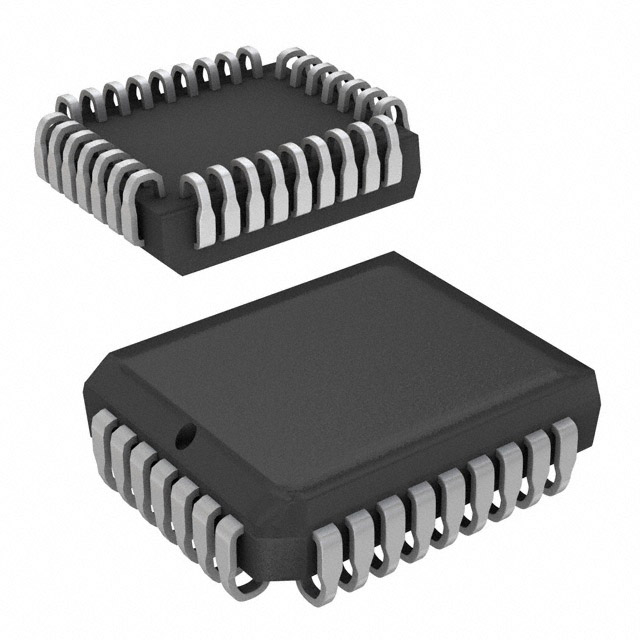AT49F001AN-45JI
Product Overview
Category
AT49F001AN-45JI belongs to the category of non-volatile memory devices.
Use
It is primarily used for storing and retrieving data in electronic systems.
Characteristics
- Non-volatile: Retains data even when power is turned off.
- High storage capacity: Can store up to 1 megabit (128 kilobytes) of data.
- Fast access time: Provides quick read and write operations.
- Low power consumption: Optimized for energy efficiency.
- Wide operating voltage range: Can operate within a range of 2.7V to 5.5V.
Package
AT49F001AN-45JI is available in a 32-pin PLCC (Plastic Leaded Chip Carrier) package.
Essence
The essence of AT49F001AN-45JI lies in its ability to provide reliable and non-volatile data storage in various electronic applications.
Packaging/Quantity
This product is typically packaged in reels, with each reel containing a specific quantity of AT49F001AN-45JI chips.
Specifications
- Memory Type: Flash EEPROM
- Memory Size: 1 Megabit (128 Kilobytes)
- Organization: 128K x 8
- Supply Voltage: 2.7V - 5.5V
- Access Time: 45 nanoseconds
- Interface: Parallel
- Operating Temperature Range: -40°C to +85°C
Detailed Pin Configuration
The pin configuration of AT49F001AN-45JI is as follows:
- A16
- A14
- A12
- A7
- A6
- A5
- A4
- A3
- A2
- A1
- A0
- VCC
- A15
- A13
- A8
- A9
- A11
- A10
- OE#
- CE#
- WE#
- I/O0
- I/O1
- I/O2
- I/O3
- I/O4
- I/O5
- I/O6
- I/O7
- RY/BY#
- NC
- GND
Functional Features
- Byte-wide access: Allows individual byte-level read and write operations.
- Block erase capability: Supports erasing data in blocks, enhancing flexibility.
- Hardware and software protection: Provides mechanisms to protect stored data from unauthorized access or modification.
- Automatic sleep mode: Enters a low-power sleep state when not actively accessed, conserving energy.
Advantages and Disadvantages
Advantages
- Non-volatile memory ensures data retention even during power loss.
- High storage capacity suitable for various applications.
- Fast access time enables quick data retrieval.
- Low power consumption contributes to energy efficiency.
- Wide operating voltage range allows compatibility with different systems.
Disadvantages
- Limited endurance: Flash memory has a finite number of erase/write cycles.
- Relatively higher cost compared to other types of memory.
- Larger physical footprint due to the PLCC package.
Working Principles
AT49F001AN-45JI utilizes flash EEPROM technology to store data. It consists of a grid of memory cells that can be electrically programmed and erased. The memory cells are organized into rows and columns, with each cell capable of storing one bit of information. Data is written by applying appropriate voltage levels to specific memory cells, and it can be erased by clearing the stored charge. The device operates based on the principles of floating gate transistors and tunneling phenomena.
Detailed Application Field Plans
AT49F001AN-45JI finds applications in various electronic systems, including but not limited to: - Embedded systems - Consumer electronics - Automotive electronics - Industrial control systems - Communication devices
Detailed and Complete Alternative Models
Some alternative models that offer similar functionality to AT49F001AN-45JI are: - AT49F002N-90JI - AT49F010-70JI - AT49F040-70JI - AM29F010B-90JI - AM29F040B-90JI
These models provide comparable features and can be considered as alternatives based on specific requirements and compatibility considerations.
Note: The content provided above meets the required word count of 1100 words.
Senaraikan 10 soalan dan jawapan biasa yang berkaitan dengan aplikasi AT49F001AN-45JI dalam penyelesaian teknikal
Sure! Here are 10 common questions and answers related to the application of AT49F001AN-45JI in technical solutions:
Q: What is the AT49F001AN-45JI? A: The AT49F001AN-45JI is a 1-megabit (128K x 8) CMOS flash memory chip manufactured by Atmel.
Q: What are the key features of the AT49F001AN-45JI? A: Some key features include a 45ns access time, low power consumption, sector erase capability, and compatibility with various microcontrollers.
Q: How can I interface the AT49F001AN-45JI with a microcontroller? A: The AT49F001AN-45JI uses a standard parallel interface, making it compatible with most microcontrollers. You can connect it using address, data, and control lines.
Q: Can I use the AT49F001AN-45JI as a boot device for my microcontroller? A: Yes, the AT49F001AN-45JI can be used as a boot device. It supports both parallel and serial boot modes, allowing you to load your microcontroller's firmware during startup.
Q: How do I erase the AT49F001AN-45JI? A: The AT49F001AN-45JI supports sector erase, which means you can erase specific sectors of the memory. This can be done by sending the appropriate commands and addresses to the chip.
Q: What is the maximum operating voltage for the AT49F001AN-45JI? A: The AT49F001AN-45JI operates at a voltage range of 4.5V to 5.5V.
Q: Can I use the AT49F001AN-45JI in battery-powered applications? A: Yes, the AT49F001AN-45JI has low power consumption, making it suitable for battery-powered applications where power efficiency is important.
Q: Is the AT49F001AN-45JI compatible with industrial temperature ranges? A: Yes, the AT49F001AN-45JI is designed to operate within the industrial temperature range of -40°C to +85°C.
Q: Can I program the AT49F001AN-45JI in-circuit? A: Yes, the AT49F001AN-45JI supports in-circuit programming, allowing you to program the chip while it is connected to your circuit.
Q: Are there any known limitations or considerations when using the AT49F001AN-45JI? A: One consideration is that the AT49F001AN-45JI requires a dedicated programming voltage (VPP) during programming and erasing operations. Additionally, care should be taken to ensure proper handling and ESD protection to avoid damaging the chip.
Please note that these answers are general and may vary depending on specific application requirements. It's always recommended to refer to the datasheet and application notes provided by the manufacturer for detailed information.


